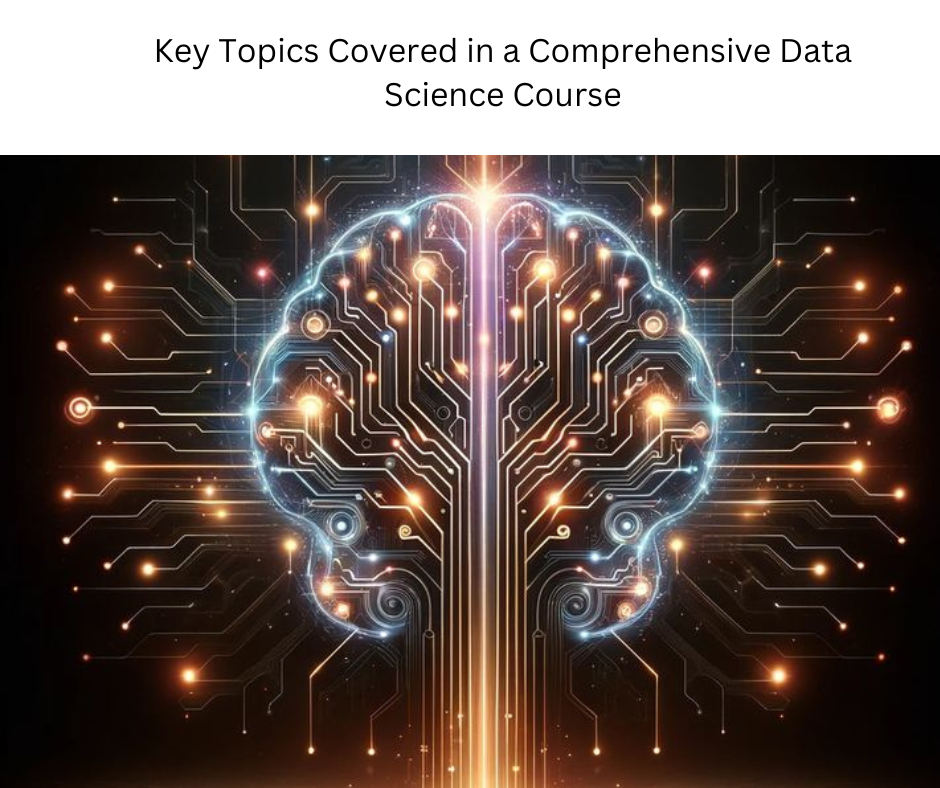Key Topics Covered in a Comprehensive Data Science Course
 Ruhi Parveen
Ruhi Parveen
Data Science is an interdisciplinary field that merges mathematics, statistics, computer science, and domain expertise to extract meaningful insights from data. A comprehensive Data Science course equips learners with the essential skills and knowledge to tackle real-world data challenges. Below is a detailed overview of the key topics typically covered in such a course.
Introduction to Data Science
Overview of Data Science
Understand the definition and importance of Data Science across various industries. Learn about the role of a Data Scientist and explore the applications of Data Science in sectors like finance, healthcare, marketing, and more.Data Science Process
Gain an understanding of the Data Science lifecycle, including data collection, cleaning, analysis, and interpretation. Get introduced to methodologies like CRISP-DM (Cross-Industry Standard Process for Data Mining).
Mathematics and Statistics for Data Science
Essential Mathematics
Delve into linear algebra (vectors, matrices, and operations), calculus (differentiation and integration basics), and probability theory (concepts of probability, conditional probability, and Bayes’ theorem).Statistical Analysis
Learn descriptive statistics (mean, median, mode, variance, and standard deviation), inferential statistics (hypothesis testing, confidence intervals, and p-values), and regression analysis (simple and multiple linear regression).
Programming for Data Science
Python for Data Science
Start with Python basics, including programming, data types, and control structures. Explore key libraries such as NumPy, Pandas, Matplotlib, and Seaborn for data manipulation, cleaning, and preprocessing.R Programming
Learn the basics of R programming, data manipulation with Dplyr and tidyr, and data visualization using Ggplot2 and other libraries.
Data Wrangling and Preprocessing
Data Collection
Discover sources of data, including structured, unstructured, and semi-structured data. Learn web scraping techniques and how to use APIs for data collection.Data Cleaning
Master techniques for handling missing data, detecting and treating outliers, and transforming data through normalization and standardization.Data Preprocessing
Focus on feature selection and engineering, data encoding (one-hot encoding, label encoding, etc.), and dimensionality reduction using PCA (Principal Component Analysis) and LDA (Linear Discriminant Analysis).
Exploratory Data Analysis (EDA)
EDA Techniques
Learn to use data visualization tools like bar charts, histograms, box plots, scatter plots, and heatmaps. Analyze summary statistics, data distribution, relationships, and correlation.EDA Tools
Utilize Python and R libraries for EDA. Get introduced to interactive dashboards with tools like Tableau or Power BI for visual exploration.
Machine Learning
Supervised Learning Explore concepts and applications of supervised learning. Study algorithms such as linear regression, logistic regression, decision trees, random forests, support vector machines, and k-nearest neighbors. Learn how to evaluate models using confusion matrices, accuracy, precision, recall, F1-scores, and ROC-AUC curves.
Unsupervised Learning
Understand clustering techniques (K-means, hierarchical clustering, DBSCAN), association rule learning (Apriori algorithm, market basket analysis), and dimensionality reduction techniques (t-SNE, PCA).Reinforcement Learning
Get an introduction to reinforcement learning, including agents, environments, and rewards. Study key algorithms like Q-learning, SARSA, and deep reinforcement learning.Model Tuning and Optimization
Learn hyperparameter tuning techniques such as grid search and random search. Understand cross-validation techniques, including K-fold cross-validation and leave-one-out cross-validation. Get introduced to model deployment tools like Flask, Docker, and AWS.
Deep Learning
Introduction to Deep Learning
Start with the basics of neural networks, including perceptron, activation functions, and backpropagation. Explore deep learning architectures like Convolutional Neural Networks (CNNs), Recurrent Neural Networks (RNNs), and Generative Adversarial Networks (GANs).Deep Learning Frameworks
Get hands-on practice with TensorFlow, Keras, and PyTorch for building, training, and deploying deep learning models.Applications of Deep Learning
Apply deep learning techniques to computer vision (object detection, image classification, segmentation), natural language processing (text classification, sentiment analysis, language translation), and time series forecasting.
Big Data and Data Engineering
Introduction to Big Data
Understand the characteristics and challenges of big data. Learn about big data technologies like the Hadoop ecosystem (HDFS, MapReduce, Hive, and Pig) and Apache Spark for big data processing.Data Engineering Concepts
Dive into ETL (Extract, Transform, Load) processes for designing and implementing data pipelines. Get an introduction to data warehousing, data lakes, and cloud computing platforms like AWS, Azure, and Google Cloud.
Data Visualization
Importance of Data Visualization
Learn the role of visualization in data-driven decision-making. Understand key principles of effective data visualization.Visualization Tools and Techniques
Create advanced visualizations in Python using Seaborn, Plotly, and Bokeh. Get introduced to dashboard creation with tools like Tableau, Power BI, and Google Data Studio. Explore custom visualizations using D3.js.Storytelling with Data
Master techniques for effective storytelling with data, creating narratives that resonate with stakeholders.
Natural Language Processing (NLP)
Basics of NLP
Start with an introduction to NLP, including text processing and language models. Learn about text pre-processing techniques like tokenization, stemming, lemmatization, and stop-word removal.Advanced NLP Techniques
Dive into sentiment analysis, topic modeling (LDA), named entity recognition (NER), and parts of speech tagging.NLP Libraries and Tools
Practice NLP in Python using libraries like NLTK, SpaCy, and Gensim. Get introduced to transformer models like BERT and GPT.
Time Series Analysis
Introduction to Time Series Data
Understand time series data, including trends, seasonality, and noise. Learn about time series decomposition using additive and multiplicative models.Time Series Forecasting Techniques
Explore forecasting techniques such as ARIMA (Auto-Regressive Integrated Moving Average) models, exponential smoothing methods, and advanced techniques like Prophet and LSTMs for time-dependent data.Practical Applications
Apply time series forecasting to real-world scenarios like sales prediction and anomaly detection.
Capstone Project
Real-World Data Science Problems
Work on a domain-specific project in finance, healthcare, retail, or another area. Execute an end-to-end Data Science project, from data collection to model deployment.Presentation and Reporting
Create a comprehensive report and present findings to a non-technical audience. Incorporate feedback and iterate on the project.
Ethics and Data Governance
Ethical Issues in Data Science
Address bias and fairness in algorithms. Understand privacy concerns and learn how to handle sensitive data responsibly.Data Governance
Focus on data quality management, ensuring accuracy, completeness, and consistency. Learn about legal considerations, including GDPR, CCPA, and best practices for data governance in organizations.
Career Guidance and Portfolio Building
Building a Data Science Portfolio
Understand the importance of a strong portfolio in job applications. Learn how to effectively showcase projects and skills and create a standout GitHub profile.Job Search Strategies
Get tips on resume writing and LinkedIn optimization for Data Science roles. Prepare for technical interviews by reviewing common questions. Explore networking strategies to connect with professionals in the Data Science community.Continuing Education and Learning
Stay updated with the latest trends in Data Science by joining online communities, attending webinars, and participating in competitions like Kaggle.
Conclusion
A comprehensive Data Science course provides a robust foundation in essential areas such as data collection, preprocessing, exploratory analysis, machine learning, deep learning, and big data technologies. By covering critical topics like programming, statistical analysis, model optimization, and practical applications, learners are well-equipped to tackle real-world data challenges. Courses often culminate in a capstone project, offering hands-on experience and a platform to build a professional portfolio. For those seeking the Best Data Science Training in Noida, Delhi, Mumbai, and other parts of India, enrolling in a reputable course can pave the way for a successful career in this dynamic field.
Subscribe to my newsletter
Read articles from Ruhi Parveen directly inside your inbox. Subscribe to the newsletter, and don't miss out.
Written by

Ruhi Parveen
Ruhi Parveen
I am a Digital Marketer and Content Marketing Specialist, I enjoy technical and non-technical writing. I enjoy learning something new.